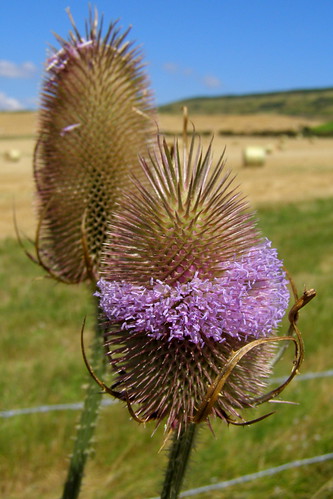Teasels – Dipsacus fullonum
- The Teasel grows as an errect biennial flowering plant up to 6 feet high.
- They have sharp downward pointing prickles on their stem.
- Flowers heads are a cluster of 2000 very small, blue-lilac flowers in a distinctive egg-shape
- Several leaf-like bracts also branch out from the base of the flower and curve upward around the head.
- Plants initially produce a basal rosette of leaves and then flowering stems are produced during the second year.
- Butterflies like to sip the nectar and goldfinches like to eat the many seeds.
Names and Uses of Teasels
- Teasels are also called ‘Johnny-prick-the-finger’ because of the sharp spikes.
- Its scientific name ‘Dipsacus‘ derives from Greek and means ‘to thirst’. Potentially due to the way rainwater collects at the base of leaves where the leaf and the stem together form a little bowl.
- Romans called it ‘Venus’s basin’ and early Christians in Ireland called it Mary’s basin’.
- The second part of its botanical name ‘fullonum‘ is derived from the term ‘a fuller’. Fuller is the old name for someone who used teasel to comb out wool.
- In some places teasel is also known by the name ‘brush and comb’. The Irish name Lus an Fhucadora translates as ‘Fuller’s Herb’.
- Teasel is also named the herbal ‘fracture healer’ to denote its ability to help heal broken bones and sinews. Other medicinal properties include, ointment to cure warts plus kidney, liver and blood tonics
Teasels and Textiles
- Teasels have long been cultivated for use in the textile industry. It has hooks on the ends of the spikes, and is used in the manufacture of cashmere, vicuna and velour fabrics.
- The spikes help brush or ‘Full’ cloth. Typical products include tennis balls and billiard tables.
- 40 yards of cloth would take 3000 teasel until fulling machines were invented.
Sources
Photo by Jim Champion on flickr under creative commons license
Conservation Northern Ireland
God’s Own County

